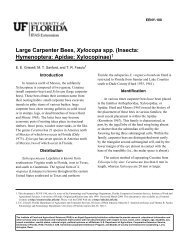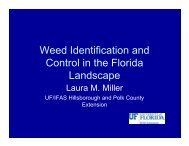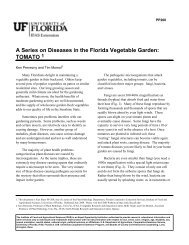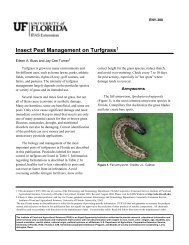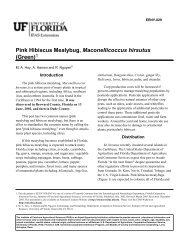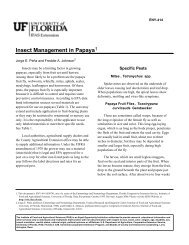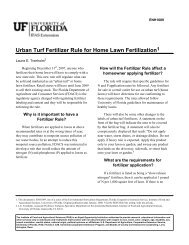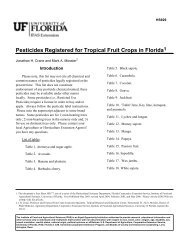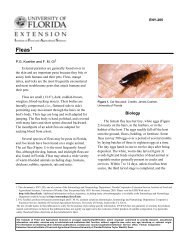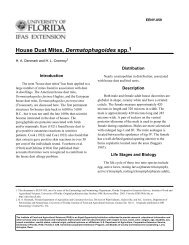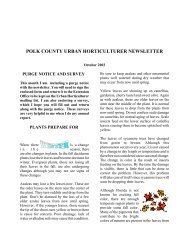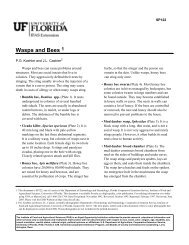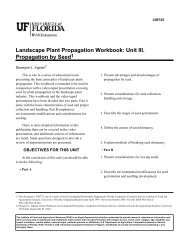Florida-Friendly Ground Covers - University of Florida
Florida-Friendly Ground Covers - University of Florida
Florida-Friendly Ground Covers - University of Florida
You also want an ePaper? Increase the reach of your titles
YUMPU automatically turns print PDFs into web optimized ePapers that Google loves.
<strong>Florida</strong>-<strong>Friendly</strong> <strong>Ground</strong> <strong>Covers</strong><br />
David Shibles<br />
Urban Horticulturist<br />
UF/IFAS Polk County Extension Service<br />
gammatwo@ufl.edu<br />
www.polkhort.com<br />
October 1 st , 2012
What is a <strong>Ground</strong> Cover?<br />
• Essentially it is any low-growing plant that can be<br />
used in the landscape to cover bare ground.<br />
• It is a functional name as a plant may function as a ground<br />
cover for one person be used as a bedding plant for<br />
someone else.<br />
• They can be used to fill in between adjacent accent plants<br />
or to frame/border a grouping <strong>of</strong> similar shrubs.<br />
• <strong>Ground</strong> covers are <strong>of</strong>ten thought <strong>of</strong> as having a creeping<br />
or climbing habit, but there are many low growing plants<br />
which serve this purpose.<br />
• They probably should be less than 3 feet tall.<br />
• Probably should not include annuals or short lived<br />
perennials.
How do they benefit the homeowner?<br />
• Can provide a surprising amount <strong>of</strong> energy savings<br />
5-7 months per year.<br />
• Evaporative cooling can lower the temperature<br />
immediately surrounding the plants by as much as<br />
9 degrees F. and can be as much as 25 degrees F.<br />
cooler than paved surfaces.<br />
• Water savings plus fertilizer and pest control savings<br />
can be significant.<br />
• Some will grow in deep shade others in full sun – some<br />
grow in both.<br />
• Apart from their value as a filler and weed suppression,<br />
many ground covers have inherent ornamental value (showy<br />
flowers attractive foliage).
Perennial peanut<br />
• Arachis glabrata<br />
• Non-native<br />
• Zones 8-11<br />
• Height – ½ to one foot<br />
• Width – one to eight feet<br />
• High drought tolerance<br />
• Make sure to purchase rhizomal type – Ecoturf<br />
or Needlepoint which are drought tolerant.<br />
• Stoloniferous type like “Repens Golden Glory”<br />
are commonly for sale in central <strong>Florida</strong>.<br />
• Flowers summer thru fall.
Perennial Peanut<br />
Advantages<br />
• Requires little to no fertilizer or water.<br />
• Does not need regular mowing.<br />
• Forms a dense mat <strong>of</strong> rhizomes when established.<br />
• Very few to no pests and diseases.<br />
Disadvantages<br />
• Does not grow well in shade and does not traffic well.<br />
• Does not take cold.<br />
• Takes an extended period to establish particularly<br />
from sprigs may give weeds a chance establish.<br />
only a few registered herbicides.<br />
• Basagran and Cadre DG will control yellow nutsedge and<br />
• some broadleaves.<br />
• Fusilade, Poast, Select and Prism are labeled for grassy<br />
weed control.
Pinto peanut – Arachis pintoi.<br />
Locally called Repens Golden Glory.<br />
Forms roots at the nodes, does<br />
not form rhizomes as does Arachis<br />
glabrata – Ecoturf/Needlepoint.<br />
Studies around the world<br />
indicate that Pinto Peanut<br />
is more prone to have winter<br />
kill, spider mite damage and<br />
have nematodes issues. Logic<br />
would dictate that they are<br />
also less drought tolerant.
Ecoturf perennial peanut on right-<strong>of</strong>-way at the Polk County Extension Office
Perennial peanuts growing between parking lot and Highway<br />
17/98 at the Polk County Extension <strong>of</strong>fice
Will not encroach into shady areas under trees.
Stand <strong>of</strong> perennial peanut planted on the right-<strong>of</strong> way<br />
<strong>of</strong> Ewell Road in Lakeland, FL.<br />
Photo by D. Shibles
Photo by Anne Yasalonis<br />
Ecoturf perennial peanut at a residence in Lakeland, FL.
Photo by Gail Crawford<br />
Ecoturf perennial peanut planted in home landscape in Bartow, FL.
Yellow Jasmine – Gelsemium sempervirens<br />
• Zones 8 and 9<br />
• Native evergreen<br />
• Fast Grower – 20-40 feet tall/20-30 feet wide.<br />
• pH 4.5 to 7.2<br />
• Medium drained soil.<br />
• Like partial shade.<br />
• Has low drought tolerance.<br />
• Yellow tubular winter through spring flowers.<br />
• Is poisonous.
Yellow Jasmine growing as<br />
a vine on a pergola at the<br />
Polk County Extension Office<br />
photo by Anne Yasalonis
St. Bernards Lily – Anthericum sanderi<br />
• All <strong>of</strong> <strong>Florida</strong> – zones 8-11<br />
• Non-native<br />
• 1 ½ feet tall ½ to 1 foot wide.<br />
• pH – 6.0 to 7.2<br />
• Likes well drained soil.<br />
• Medium drought tolerance.<br />
• Likes full sun to partial shade.<br />
• Has white spring flowers.
St. Bernards Lily growing in<br />
the demonstration garden<br />
at the IFAS Plant City<br />
Campus.<br />
photo by Anne Yasalonis
Bugleweed – Ajuga reptans<br />
• North and central <strong>Florida</strong> – zones 8 to 9a.<br />
• Non-native<br />
• pH – 6.0 to 7.2<br />
• Fast growth<br />
• ½ to 1 foot tall 1 to 2 feet wide.<br />
• Well drained soil.<br />
• Medium drought tolerance.<br />
• Full sun, partial shade to full shade.<br />
• Purple/blue foliage<br />
• Spring through summer flowers.<br />
• Many cultivars.<br />
• Is susceptible to many diseases.
Photo by Anne Yasalonis<br />
Bugleweed growing at a residence in southwest Lakeland, FL.
Cast iron Plant – Aspidistra elatior<br />
• Most <strong>of</strong> <strong>Florida</strong> – zones 8b through 11.<br />
• Non-native<br />
• Slow grower<br />
• 1 to 3 feet tall – 1 to 3 feet wide.<br />
• pH – 6.0 to 7.2<br />
• Well drained soil.<br />
• Medium drought tolerance.<br />
• Does best in part to full shade.<br />
• Has dark green glossy foliage.<br />
• Has brown flowers periodically throughout the year.<br />
• Tolerates deep shade.
‘Milky-Way’ Cast Iron Plant<br />
(photos by Plant Delights Nursery)<br />
Raleigh, N.C.<br />
Cast Iron Plant<br />
Photo by<br />
Stephen Pategas-Hortus Oasis<br />
FDACS photo shows striped,<br />
normal and Milky-Way types
Cast iron plant growing in a landscape in southwest Lakeland, FL.<br />
Photo by D. Shibles
Sweet Potato Vine – Ipomea spp.<br />
• Also called Railroad vine.<br />
• Native cultivars.<br />
• All <strong>of</strong> <strong>Florida</strong> – zones 8 to 11.<br />
• Grows fast.<br />
• 10 to 20 feet tall and 10-40 feet wide.<br />
• pH 6.0 to 7.2<br />
• Well to medium drained - any texture soil.<br />
• High drought tolerance.<br />
• Full sun to part shade.<br />
• Medium salt tolerance.<br />
• Flower color varies.<br />
• Spreads easily.<br />
• Provides food for wildlife.
Photo by Anne Yasalonis<br />
Ornamental sweet potato vine growing in a Landscape<br />
in southwest Lakeland, FL
Two cultivars <strong>of</strong> sweet potato vine<br />
growing in a pot at the Polk County<br />
Extension Office.<br />
Photo by Anne Yasalonis
Photo by D. Shibles<br />
Edible sweet potato growing in a terrace at a Lakeland residence.
Holly Fern – Crytomium falcatum<br />
• Most <strong>of</strong> <strong>Florida</strong> – zones 8b to 11.<br />
• Non- Native<br />
• Evergreen fern<br />
• Good low maintenance ground cover.<br />
• pH – 6.2 to 7.0<br />
• Does not grow exceptionally fast or slow.<br />
• 2-3 feet tall and 3-4 feet wide.<br />
• Well to medium drained soil.<br />
• Full sun to full shade.<br />
• Susceptible to pests.
Holly ferns – photos courtesy <strong>of</strong> <strong>Florida</strong>ta
Autumn Fern – Dryopteris erythrosora<br />
• All parts <strong>of</strong> <strong>Florida</strong> – zones 8-11<br />
• Native status depends on variety.<br />
• Slow growing<br />
• 1-4 feet tall and 3-4 feet wide.<br />
• pH – 4.5 to 6.5<br />
• Well drained soil<br />
• Medium drought tolerance.<br />
• Part sun to full shade.<br />
• Low to no salt tolerance.<br />
• Dark green fern with delicate appearance.<br />
• Fronds appear reddish when young.<br />
• Choose species on growing conditions.<br />
• Combine with Mahonia fortuneii and Holly Fern<br />
for a mixed planting in a shady location.
Autumn Fern ‘Brilliance’<br />
Autumn Fern ‘Brilliance’
Autumn fern growing in the<br />
landscape at the Polk County<br />
Extension Office.<br />
Photos by D. Shibles
Twin Flower – Dyschoriste oblongifolia<br />
• All <strong>of</strong> <strong>Florida</strong> – zones 8-11<br />
• Native<br />
• Fast growing.<br />
• ½ to 1 foot tall and 1 to 1½ foot wide.<br />
• pH 6.0 to 7.2<br />
• Well drained soil.<br />
• High drought tolerance.<br />
• Lavender year-round flowers.<br />
• Larval food for common buckeye butterfly.
Photo by Anne Yasalonis<br />
Twin flower photo taken at the Polk County<br />
Extension Office in Bartow, FL.
Twin flower in landscape at<br />
the Polk County Extension<br />
Office in Bartow, FL.<br />
Photo by Anne Yasalonis
Blue Daze – Evolvulus glomeratus<br />
• Central and south <strong>Florida</strong> – zones 9 to 11.<br />
• Native to Brazil and Paraguay<br />
• Does not grow exceptionally fast or slow.<br />
• ½ to 1 foot tall and 1 to 2 feet wide.<br />
• pH – 6.0 to 7.2<br />
• Well drained soil.<br />
• Medium drought tolerance.<br />
• Part shade<br />
• High salt tolerance.<br />
• Creates grey/green carpet-like cover accented<br />
with sky blue flowers spring through summer.
Blue daze needs full sun but some<br />
protection from frosts and freezes.
Photo by N. Winter<br />
Here blue daze is mixed with ‘Pr<strong>of</strong>usion Fire’ zinnia.
Tampa Vervain – Glandularia tampensis<br />
• South and central <strong>Florida</strong> – zones 9-11<br />
• Native – also known as Verbena tampensi<br />
• Does not grow exceptionally fast or slow.<br />
• 1½ to 2 feet tall and 1 to 2 feet wide.<br />
• pH 6.2 to 7.0<br />
• Well drained sandy soil.<br />
• High drought tolerance.<br />
• Full sun<br />
• Low to no salt tolerance.<br />
• Attracts butterflies.<br />
• Purplish pink/white summer flowers.
Tampa Vervain growing in the<br />
Landscape at the Polk County<br />
Extension Office with Sand<br />
Cord Grass in the background.<br />
Photo by D. Shibles
Algerian Ivy – Hedera canariensis<br />
• Also called Canary Island Ivy and Madiera Ivy<br />
• Most <strong>of</strong> <strong>Florida</strong> – zones 8b to 11.<br />
• Non-native<br />
• Growth fast – will spread aggressively.<br />
• ½ to 1 feet tall and 1 to 6 feet wide.<br />
• Leaves may get 6-8 inches across.<br />
• pH – 4.5 to 7.2<br />
• Any soil type.<br />
• Well drained soil.<br />
• Medium drought tolerance.<br />
• For shady areas.<br />
• Medium salt tolerance.<br />
• Distinctive red leaf stems.<br />
• Beautiful, thick leathery foliage.<br />
• Rich groundcover in the shade.
Photo – <strong>University</strong> <strong>of</strong> Illinois<br />
Algerian Ivy foliage slightly<br />
broader than English Ivy<br />
Photo courtesy <strong>of</strong> <strong>Ground</strong> Effects Nursery<br />
There are several forms <strong>of</strong><br />
Variegated Algerian Ivy<br />
Hedera canariensis
English Ivy – Hedera helix<br />
• North and central <strong>Florida</strong> – zones 8-9<br />
• Non-native<br />
• Fast growing – watch for aggressive spread.<br />
• 1 to 2 feet high and 2 to 5 feet wide.<br />
• pH – 4.5 to 7.2<br />
• Any well-drained soil texture.<br />
• Medium drought tolerance.<br />
• Shady locations.<br />
• Leaves provide dark green mat <strong>of</strong> foliage.<br />
• Aerial roots will grow up tree trunks, walls, trellises.
English Ivy makes a nice groundcover<br />
Photo by Rosie Lerner – Purdue <strong>University</strong><br />
Don’t let it escape up trees<br />
Photo by Carole Bergmann<br />
Or buildings (at Cornell)
Shore Juniper – Juniperus conferta<br />
• North and central <strong>Florida</strong> – zones 8-9<br />
• Non-native<br />
• Grows slowly – 1 to 2 feet tall and 6 to 10 feet wide.<br />
• pH – 4.5 to 8.0<br />
• Well drained sandy soil.<br />
• High drought tolerance.<br />
• Full sun<br />
• High salt tolerance.<br />
• It is flammable – keep 30 feet away from buildings.<br />
• Used for dune stabilization.<br />
• Susceptible to diseases.
Blue Pacific Juniper<br />
(Plant City IFAS Campus)<br />
Photo by Anne Yasalonis
Blue Pacific Juniper – in the<br />
landscape at the Polk County<br />
Extension Office in Bartow, FL.<br />
Photos by D. Shibles
Creeping Juniper – Juniperus horizontalis<br />
• North and central <strong>Florida</strong> – zones 8a to 9a.<br />
• Non-native<br />
• Neither fast nor slow growth.<br />
• ½ to 1 foot tall and 8 to 10 feet wide.<br />
• pH – 4.5 to 8.0<br />
• Any well drained soil texture.<br />
• High drought tolerance.<br />
• Does not tolerate water-logged conditions.<br />
• Full sun – plants thin in shady areas.<br />
• Medium salt tolerance.<br />
• Attracts birds.<br />
• Susceptible to pests and diseases.
This variety is called ‘Twomedicine’.<br />
This unusual variety with yellowish<br />
foliage is called ‘Motherlode’.
Trailing Lantana – Lantana montevidensis<br />
• Central and south <strong>Florida</strong> – zones 9 – 11.<br />
• Non-native<br />
• Fast growth – 1 to 3 feet tall and 4 to 8 feet wide.<br />
• pH – 4.5 to 8.0<br />
• Any well drained soil texture.<br />
• Medium drought tolerance.<br />
• Full sun<br />
• Attracts butterflies and birds.<br />
• White/pink/lavender summer through fall flowers.<br />
• Susceptible to pests and diseases.
Photo by Anne Yasalonis<br />
Trailing Lantana growing at a residence in southwest Lakeland, FL.
Trailing Lantana growing in a<br />
landscape in southwest Lakeland.<br />
Photo by Anne Yasalonis
Photo by Anne Yasalonis<br />
Trailing lantana growing in a landscape a residence in Lakeland, FL.
Liriope – Liriope muscari and cvs.<br />
• Also called monkey grass, Lily Turf and Border Grass<br />
• North and central <strong>Florida</strong> – zones 8-9.<br />
• Non-native<br />
• Neither fast nor slow growth.<br />
• 1 to 2 feet tall and 1 to 2 feet wide.<br />
• pH – 4.5 to 8.0<br />
• Well drained any textured soil.<br />
• Medium drought tolerance.<br />
• Full sun to part shade to full shade.<br />
• Medium salt tolerance.<br />
• Purple summer flowers.<br />
• Forms a solid groundcover in a few years.<br />
• Variegated cultivar is damaged by frost and<br />
is susceptible to pests.
Photo by D. Shibles<br />
Green Giant Liriope along with several bromeliads growing under<br />
a Laurel Oak tree at the Polk County Extension Office in Bartow, FL.
Green Giant Liriope growing in the<br />
landscape at a Lakeland, FL residence.<br />
Photo by Anne Yasalonis
Small pretty flowers which require<br />
a close look.<br />
A bed <strong>of</strong> liriope in Tallahassee,<br />
<strong>Florida</strong> in bloom.
Powderpuff – Mimosa strigillosa<br />
• Also called Sunshine Mimosa<br />
• All <strong>of</strong> <strong>Florida</strong> – zones 8-11.<br />
• Native perennial<br />
• Fast growing – 1-2 feet tall and1-2 feet wide.<br />
• Well drained any textured soil.<br />
• Medium drought tolerance.<br />
• Full sun<br />
• Medium salt tolerance.<br />
• Attracts butterflies.<br />
• Pink powderpuff flowers.
Sunshine mimosa growing at the home <strong>of</strong><br />
one <strong>of</strong> the Polk County Master Gardeners<br />
in Lakeland, FL.<br />
Photo by Anne Yasalonis
Giant Sword Fern – Nephrolepis biserrata<br />
• Not to be confused with the exotic invasive fern<br />
N. cordiflora.<br />
• Central and south <strong>Florida</strong>.<br />
• Native<br />
• Neither fast nor slow grower.<br />
• ½ to 4 feet tall and 1 to 4 feet wide.<br />
• pH – 6.0 to 6.8<br />
• Medium drained clay/loam soil.<br />
• Part to full shade.<br />
• Low to no salt tolerance.<br />
• May spread beyond small gardens.<br />
• Looks best in full shade.
<strong>University</strong> <strong>of</strong> <strong>Florida</strong> photo<br />
<strong>University</strong> <strong>of</strong> <strong>Florida</strong> photo
Sword Fern – Nephrolepis exaltata<br />
• Central and south <strong>Florida</strong> – zones 9-11.<br />
• Native – not to be confused with N. cordifolia.<br />
• Neither fast nor slow grower.<br />
• 1 to 4 feet tall and 1 to 4 feet tall.<br />
• pH – 6.0 to 6.8<br />
• Medium drained any textured soil.<br />
• Medium drought tolerance.<br />
• Part to full shade.<br />
• Low to no salt tolerance.<br />
• May spread beyond small gardens.<br />
• Looks best in full shade.
<strong>University</strong> <strong>of</strong> <strong>Florida</strong> photos
Mondo Grass – Ophiopogan japonicus<br />
• Also known as Dwarf Lilyturf and Dwarf Liriope.<br />
• All <strong>of</strong> <strong>Florida</strong> – zones 8-11.<br />
• Non-native<br />
• Slow growing – ½ to 1 foot tall and ½ to 2 feet wide.<br />
• pH – 6.0 to 7.2<br />
• Any textured well drained soil.<br />
• Medium drought tolerance.<br />
• Part to full shade.<br />
• Medium salt tolerance.<br />
• White summer flowers.<br />
• Dark green grass-like mounds.<br />
• Tolerates some foot traffic.
Mondo grass growing between pavers<br />
at Bok Tower Gardens in Lake Wales, FL.<br />
Photo by D. Shibles
Photo by D. Shibles<br />
Mondo grass placed in a triangle at the junction <strong>of</strong> two<br />
sidewalks at the Polk County Extension Office in Bartow, FL.
Photo by Anne Yasalonis<br />
Mondo grass growing as a sidewalk border at a Lakeland, FL residence.
Leatherleaf Fern – Rumohra adiantiformis<br />
• Central and south <strong>Florida</strong> – zones 9b-11.<br />
• Non-native<br />
• Evergreen fern with triangular-shaped, dark<br />
glossy green leaflets.<br />
• Grows neither fast or slow.<br />
• 1-3 feet tall and 4-5 feet wide.<br />
• pH – 6.0 to 7.2<br />
• Medium drained any textured soil.<br />
• Partial to full shade.<br />
• Medium drought tolerance.<br />
• Low to no salt tolerance.
Southern Shield Fern – Thelypteris kunthii<br />
• North, central and south <strong>Florida</strong> - zones 8-11.<br />
• Native<br />
• Robust fern with graceful light green foliage.<br />
• Fast growing – 2-3 feet tall and 2-4 feet wide.<br />
• May spread out <strong>of</strong> small gardens become<br />
difficult to control.<br />
• pH – 6.0 to 8.0<br />
• Any well to medium drained soil.<br />
• Medium drought tolerance.<br />
• Full sun to total shade.<br />
• Low to no salt tolerance.
Photo by D. Shibles<br />
Southern Shield Fern in the landscape at the Polk County Extension Office.
Photo by D. Shibles<br />
Southern Shield Fern in the landscape at the Polk County Extension Office.
Asiatic Jasmine – Trachelospermum asiaticum<br />
• AKA Small leaf Confederate Jasmine<br />
• Most <strong>of</strong> <strong>Florida</strong> – zones 8b-10.<br />
• Non-native<br />
• Small, dark green glossy leaves with light green veins.<br />
• Fast growing – 1 to 3 feet tall and 1-30 feet wide.<br />
• Spreads aggressively.<br />
• pH – 4.5 to 8<br />
• Well drained to medium well drained – any texture.<br />
• Medium drought tolerance.<br />
• Full sun to partial shade.<br />
• Medium salt tolerance.<br />
• Tolerates foot traffic.<br />
• Susceptible to pests and diseases.<br />
• May have cold damage when temperatures in the 20’s.
Photo by D. Shibles<br />
Variegated Asiatic Jasmine forming a border between a path and a bed<br />
<strong>of</strong> dwarf variegated Schefflera at a landscape in southwest Lakeland, FL.
Photo by D. Shibles<br />
A bed <strong>of</strong> Variegated Asiatic Jasmine in a landscape in southwest Lakeland, FL.
A bed <strong>of</strong> green cultivar Asiatic Jasmine<br />
growing at a residence in Lake Ashton, FL.<br />
Photo by Anne Yasalonis
A bed <strong>of</strong> variegated Asiatic Jasmine<br />
intruding into a neighboring walkway<br />
and into neighboring shrubs.<br />
Photos by D. Shibles
A mix <strong>of</strong> variegated and green Asiatic Jasmine<br />
climbing up the wall <strong>of</strong> a Lakeland, FL home.<br />
This plant will require maintenance 4-5 times<br />
per year. There is also obvious staining on the<br />
brick facia.<br />
Photos by D. Shibles
Confederate Jasmine/Star Jasmine<br />
Trachelospermum jasminoides<br />
• Most <strong>of</strong> <strong>Florida</strong> – zones 8b-10.<br />
• Non-native<br />
• Fast growing – 1 to 3 feet tall and 1 to 30 feet wide.<br />
• pH – 4.5 to 8.0<br />
• Medium drought tolerance.<br />
• Well to medium drained any textured soils.<br />
• Full sun to partial shade.<br />
• Low to no salt tolerance.<br />
• Attracts hummingbirds.<br />
• White, fragrant, showy spring flowers.<br />
• Susceptible to diseases.
During April and May the plant goes<br />
two-tone as it flushes light green with<br />
new growth. Shortly thereafter one<br />
inche white flowers are produced<br />
with a wonderful fragrance.
Periwinkle – Vinca major<br />
• North and central <strong>Florida</strong> – 8a to 9.<br />
• Non-native<br />
• Neither fast nor slow growing<br />
• 1 to 2 feet tall and 1 to 5 feet wide.<br />
• pH – 6.0 to 7.2<br />
• Medium drought tolerance.<br />
• Well to medium drained any textured soil.<br />
• Full sun to full shade.<br />
• Low to no salt tolerance.<br />
• Oval or heart-shaped dark green leaves.<br />
• Blue/purple/lavender summer flowers.<br />
• Good for small shaded gardens.<br />
• Does not tolerate hot dry conditions.
Photo by D. Shibles<br />
A colorful border <strong>of</strong> Periwinkles between turfgrass and Thryallis shrubs.
Photo by D. Shibles<br />
Photo by D. Shibles<br />
Perwinkles mixed with Melampodiums forming a colorful border between<br />
St. Augustine turf and a walk way.
Coontie, <strong>Florida</strong> Arrowroot, <strong>Florida</strong> Zamia<br />
Zamia floridana<br />
• Most <strong>of</strong> <strong>Florida</strong> – zones 8b to 11.<br />
• Native – <strong>Florida</strong>’s only native cycad.<br />
• Small, palm-like perennial plant<br />
• Slow growing – 1 to 5 feet tall and 3 to 5 feet wide.<br />
• pH – 4.5 to 8.0<br />
• Well drained any textured soil.<br />
• High drought tolerance.<br />
• Full sun to full shade.<br />
• High salt tolerance.<br />
• Is the sole larval food plant for the Atala butterfly.<br />
• Susceptible to pests and cold damage in the 20’s.
Photo by D. Shibles<br />
Coonties placed in a bed with rock mulch separating a cement<br />
sidewalk and a mulched path.
Cardboard Plant – Zamia furfuracea<br />
• Central and south <strong>Florida</strong> – zones 9b to 11.<br />
• Non- native<br />
• Slow growing – 2 to 5 feet tall and 5 to 8 feet wide.<br />
• pH – 4.5 to 8.0<br />
• High drought tolerance.<br />
• Well drained – any texture.<br />
• Full sun to full shade.<br />
• High salt tolerance.<br />
• Seeds and caudex poisonous.<br />
• Freezes in central <strong>Florida</strong> and can come back.
Photo by D. Shibles<br />
Cardboard plant growing in a mulched bed separating a sidewalk and<br />
a parking lot at the Polk County Extension <strong>of</strong>fice.
Beach Sunflower – Helianthus debilis<br />
• All <strong>of</strong> <strong>Florida</strong> – zones 8 – 10.<br />
• <strong>Florida</strong> native.<br />
• Fast growing.<br />
• Size: 1 to 2 feet tall and 2 to 3 feet wide.<br />
• Well drained sandy soil – will decline if soil is<br />
too rich or too moist.<br />
• Very drought tolerant.<br />
• High salt tolerance.<br />
• Full sun.<br />
• Has 2 inch yellow sunflowers with a brown<br />
center – blooms all year.<br />
• Fruit is a small kernel with an oily seed – eagerly<br />
sought by birds and small mammals.<br />
• Has few pests.
Photo by D. Shibles<br />
Beach sunflower in a mulched bed separating Schellings holly from a<br />
parking lot at the Polk County Extension Office.
Beach sunflowers growing down<br />
a terrace at a southwest Polk<br />
County residence.<br />
Photos by D. Shibles
Aloe – Aloe spp.<br />
• Consists <strong>of</strong> a basal rosette <strong>of</strong> thick fleshy lanceolate<br />
leaves <strong>of</strong>ten variegated with s<strong>of</strong>t spiny margins.<br />
• Grows well in all <strong>of</strong> <strong>Florida</strong> – zones 8 to 11.<br />
• Inflorescence produced in the spring on a tall <strong>of</strong>ten<br />
branched bloom spike – most produce <strong>of</strong>fsets.<br />
• Full sun with partial afternoon shade.<br />
• Well drained sandy soil.<br />
• Not all species <strong>of</strong> aloe have emollient sap.<br />
• Species with lots <strong>of</strong> <strong>of</strong>fsets can spread 10 inches/year.<br />
• Clumping aloes are especially useful as a ground cover<br />
in a dry rock garden.<br />
• May require water during prolonged droughts.
Photo by Anne Yasalonis<br />
Aloe growing in a bed at the base <strong>of</strong> a foundation at a residence<br />
in southwest Lakeland, FL.
In the winter and spring medicinal<br />
aloe (Aloe vera) bares small tubular<br />
yellow flowers on branched stalks up<br />
to 3 feet tall.
Blue-eyed Grass – Sisyrinchium angustifolium<br />
• All <strong>of</strong> <strong>Florida</strong> – zones 8 through 11.<br />
• <strong>Florida</strong> native.<br />
• Grows slowly and reachs 6 to 12 inches tall and wide.<br />
• Plants will survive surprisingly hot and dry weather,<br />
but under stress are prone to attack by root mealybugs.<br />
• Ideally grow them in moist soil in full sun.<br />
• They can be propagated by seed or division.<br />
• The flowers are proportionately rounded and occur in<br />
rich shades <strong>of</strong> blue, purple or violet.<br />
• Albino forms with pure white flowers are known to<br />
occur.
Blue-eyed Grass in a mulched bed<br />
separating shrubs and turfgrass. The<br />
photo was taken at a residence in<br />
southwest Lakeland, FL.<br />
Photo by Anne Yasalonis
Mid-summer Aster, Fleabane or Mexican Daisy<br />
Erigeron karavinskianus ‘’Pr<strong>of</strong>usion’<br />
• All parts <strong>of</strong> <strong>Florida</strong> – zones 8a to 10.<br />
• Non-native<br />
• Spreading 6 to 12 inches.<br />
• Is cold hardy.<br />
• Flowers – many 3/4 inch white to pink daisy-like<br />
flowers with yellow centers.<br />
• Leaves are gray-green with a fine texture.<br />
• Takes full sun to part shade.<br />
• Drought tolerant – does best in well drained soil.<br />
• Salt tolerance – medium.<br />
• Pest problems – generally free <strong>of</strong> pests.<br />
• Propagation – cuttings and division.
Photo by D. Shibles<br />
Mid-summer Aster planted in a mulched bed at the Polk<br />
County Extension Office separating a planting <strong>of</strong> Liriope<br />
and a sidewalk.
Photo by D. Shibles<br />
A close-up <strong>of</strong> the Mid-summer Aster flower from a planting<br />
at the Polk County Extension Office.
Pineland Heliotrope – Heliotropium polyphyllum<br />
• All <strong>of</strong> <strong>Florida</strong> – zones 8 to 11.<br />
• Native<br />
• Partly erect (6- 8 inches tall) – stems 6 to 18 inches<br />
long.<br />
• Prostrate forms only 1 to 3 inches tall.<br />
• Plants bare hundreds <strong>of</strong> snowy white or yellow flowers<br />
most <strong>of</strong> the year in central and south <strong>Florida</strong>.<br />
• Need annual pruning to the ground in late winter/early<br />
spring to maintain neat appearance.<br />
• Spread by root suckers and self sown seed.<br />
• Prefers rather dry to moist soil in full sun.<br />
• Flowers attract many nectar seeking insects including<br />
butterflies.
Pineland Heliotrope separating<br />
Turfgrass and a sidewalk at<br />
a residence in southwest<br />
Lakeland, FL.<br />
Photo by Anne Yasalonis
Photo by Anne Yasalonis<br />
Pineland Heliotrope separating turfgrass and a sidewalk at<br />
a residence in southwest Lakeland, FL.
A couple <strong>of</strong> possibilities as ground covers:<br />
• Peace lilies<br />
• Spider plant
Peace Lily - Spathiphyllum cochlearispathum<br />
• Central and possibility south <strong>Florida</strong><br />
• Not known to stand cold temperatures.<br />
• Medium to fast growth.<br />
• Filtered light to full shade.<br />
• Reach 3-4 feet tall.<br />
• Produces a pr<strong>of</strong>usion <strong>of</strong> white flowers.<br />
• Some maintenance required to remove spent flowers.<br />
• Require minimal amounts <strong>of</strong> water and fertilizer.<br />
• Generally pest and disease free.<br />
• A number <strong>of</strong> landscapes in the Lakeland area have<br />
these plantings.<br />
• The following photos are peace lilies which have<br />
survived outside winters at a Lakeland residence<br />
under a large sand live oak tree for 3-4 years.
The parents <strong>of</strong> these plants<br />
were kept in pots for many<br />
years in a lanai in which the<br />
temperature did not go<br />
below freezing. They were<br />
transplanted to the outside<br />
landscape about 3 years ago.<br />
Peace lilies in a mulched bed<br />
under a sand live oak tree.<br />
They are covered during<br />
frosts and freezes with<br />
freeze cloth. The plants<br />
have shown little to no cold<br />
damage.<br />
Photos by D. Shibles
Spider Plant – Chlorophytum comosum<br />
• Central and possibility south <strong>Florida</strong>.<br />
• Require little to no fertilizer.<br />
• Appear to be pest and disease free.<br />
• Require some maintenance as they produce<br />
numerous outgrowths.<br />
• Survive under live oak trees during cold weather<br />
• without additional protection.
Caladiums surrounded by an oblong ring<br />
<strong>of</strong> spider plants at a southwest Lakeland, Fl.<br />
residence under a live oak tree.<br />
Photos by D. Shibles



